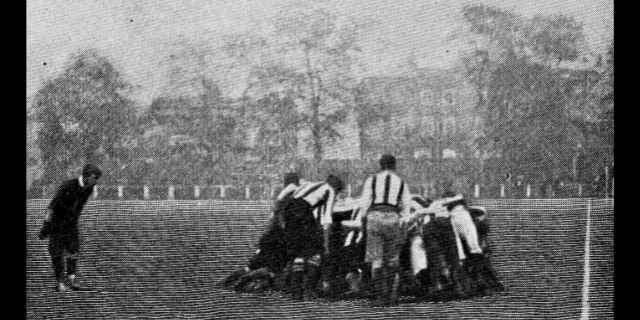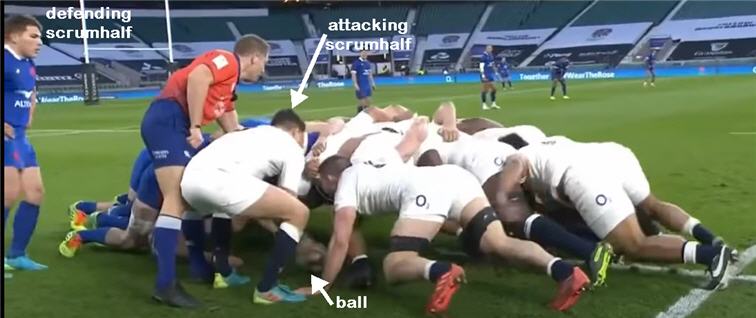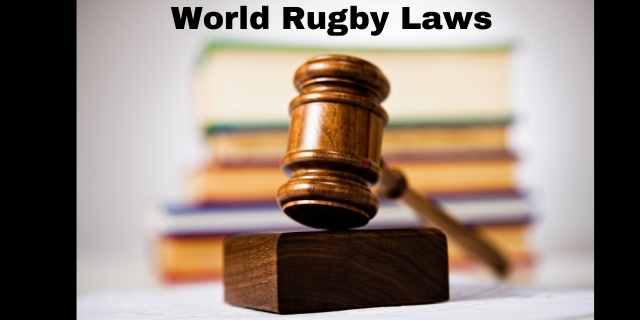Now that rugby referees wear microphones in international and top club matches, we can hear what they say to control the scrum. The exact phrase is mandatory as part of the laws of World Rugby.
So, what do referees say in the scrum?
Since 2013, rugby referees say three words to initiate a scrum. “Crouch, Bind, Set” is the current sequence:
- “Crouch” tells the forwards to drop into a low position.
- “Bind” tells the props to grip their opponent’s jersey.
- “Set” tells the players to engage and compete.
This article details the reasons behind the current call of “Crouch, Bind, Set”.
And we’ll look at the previous calls and why they were ditched. Are you wondering what happened to “Pause” and “Engage”? Read on...
A Quick History Of Rugby Scrum Calls

Rugby scrum calls have changed over the years. There have been at least three other versions since the 1980s. Each change was primarily due to concerns for player safety, with an added hope of reducing resets and penalties.
Here are the major rugby scrum calls and their dates of introduction:
- 2013 – “Crouch, Bind, Set”
- 2012 – “Crouch, Touch, Set”
- 2007 – “Crouch, Touch, Pause, Engage”
- 1990s/2000s – “Crouch And Hold, Engage”
- 1990s/2000s – Other Variants
It wasn’t until 2007 that the International Rugby Board insisted on a standard call across rugby-playing countries. Before that, “Crouch And Hold, Engage” was used across many countries. But it wasn’t mandatory, and some regions had their own variations.
To understand the current calls, it’s easiest to describe the changes in the order that they happened. That will explain the disappearance of Engage, Pause, and Touch – in that order.
Crouch And Hold, Engage
If you watch early 20th-century footage of rugby matches, you’ll see there was no real need for the referee to control the engagement of the scrum.
Opposing forwards would line up, and the front-rows would lean into each other. The aim was to get the ball away, not to push your opponents backward.
Over the decades, dominating the scrum became more and more important to winning a game. Each side was looking for the dominant “hit”, by pushing hard to gain ground when the two front-rows come together.
This coming together is known as engaging.
“Engage”

On the 2001 Lions tour, the referee call was simply “Engage”.
When he whistled for a scrum, the forwards would line up and crouch without direction from the referee. They were shouting instructions amongst themselves, but that’s for another article.
Through the 90s and early 000s, different regions were trying different calls. Sometimes the calls at underage level were different from adult level.
“Crouch And Hold, Engage”
Gradually, “Crouch And Hold, Engage” became the most commonly used call at international level. But even then, there were differences in the cadence of the calls.
Some countries kept the Crouch and Hold calls clearly separated. In contrast, New Zealand had a more garbled “Crouch-‘N’-Hold” as if it was a single phase, and then the Engage.
The idea behind the “Hold” phase was that the referee would ensure that the opposing front-rows were square and steady. In theory, this would reduce the number of uncompleted scrums. In practice, it allowed opposing sides to time the “hit” on engagement.
Concerns Increase Around Scrums
As the engagement became more forceful, injuries were also becoming more prevalent for front row players.
Scrums were also becoming an increasingly messy part of the game. Either or both sides would drop to their knees (go to ground), or straighten and stand up.
The referee awards a penalty if the fault is clear on one side. But often it’s not clear.
This would lead to seemingly endless scrum resets. There’s nothing more tedious than watching a repeating sequence of uncompleted scrums.
Television supremos and the International Rugby Board knew that this was damaging the potential growth of the audience.
You can picture the blazers shaking their heads in the boardroom. Something must be done!
Crouch, Touch, Pause, Engage

World Rugby introduced a mandatory new sequence of rugby calls in 2007. “Crouch, Touch, Pause, Engage” was the new standard call for referees.
“Touch”
The “Touch” call had been around in underage rugby for years. Props reached out to tap the opposing player’s arm, and then withdrew their hand.
The goal was to ensure the front rows were at a correct distance and had steadied themselves.
Watching senior internationals perform the Touch was comical at times, particularly if they hadn’t practiced it at underage level.
Different players pawed the air or slapped a shoulder. Some players tried a sneaky hard punch.
One international prop would stare at the ground and swiftly tap/slap the cheek of his opponent. Then say “sorry, sorry”, as if his aim was awry.
Eventually, a smart ref gave him a good talking-to while threatening a card. That put a stop to his antics.
“Pause”
The “Pause” call replaced the “Hold”. In this new sequence, the players weren’t bound yet (i.e. the props weren’t gripping each other’s jerseys).
The “Pause” call also brought out the thespian credentials of some officials. Some referees liked to bellow an elongated call dramatically.
There’s no doubt that the rugby law-makers hoped that the Pause would ensure steady scrums and reduce injuries. But again, opposing players simply readied themselves for a bigger “hit”.
It also increased the time spent crouching in the scrum. This was an increasing strain on heavy forwards as a match went on. It was no surprise to see weary props sinking into the engagement and immediately falling down.
What happens when both sides are deemed to have collapsed the scrum?
Hooray, another reset (said no supporter ever).
Once again, the powers-that-be figured that something must be done.
Crouch, Touch, Set
The “Crouch, Touch, Set” call was a short-lived call introduced by World Rugby in 2012.
One of the major changes was the removal of the Pause phase, which had been long criticized. The other major change was switching the Engage call to “Set”.
The “Set” call tells the front rows to come together square and steady. There should be no push until the scrum-half introduced the ball.
This was designed in part to reduce the force of the hit. But it seemed to make little difference.
There was a lot of focus by critics on the Touch phase. By forcing props to withdraw their outstretched hands, the end result could be a lurch forward during the Set – and a collapsed scrum.
Crouch, Bind, Set
The International Rugby Board took the scrum problems so seriously that they commissioned a major research project for £500,000 ($685,000 or €565,000).
The study led by the University of Bath observed that while less than 10% of playing injuries occurred in the scrum, they made up 40% of serious injuries. Serious scum injuries usually affect the spine and can be life-changing.
The researchers identified the collision (or “hit”) during engagement as the main source of injuries. That was no surprise to the rugby community.
But the study went on to observe and test different referee scrum calls for the safest version.

“Crouch, Bind, Set”
The “Crouch, Bind, Set” scrum call was trialed in New Zealand in 2013. The change rolled out internationally over time. The 2016 Six Nations tournament adopted this scrum call.
This call removes the Touch phase.
The “Bind” call tells the props to reach out and grip the arm of the opposing player.
The “Set” call tells the pack to position themselves square and steady, and engage.
The main effect of this call sequence is that the front rows are already binding when they get to engage. Without the lurch or drive into contact, the force that pushing can exert is reduced.
The impact of the new call
The research project observed a 25% reduction in the force of the collision.
This didn’t remove the advantage of a strong and dominant scrum. A pack can still push their opponents backward and win a penalty.
There is a detailed rundown from an angle of physics and impact velocity in this article.
I’ve hunted for recent statistics on injuries, but these are not readily available.
New “brake foot” rules
There was an unintended and unwanted consequence of the “crouch, bind, set” sequence.
Hookers started raising concerns about the extra pressure that was being applied to their necks. Medical staff also got increasingly worried.
The laws were recently changed to try to reduce the extra load being applied in scrums. We go into this in depth in our article on axial loading and the “brake foot” in scrums.
More About Scrums
Check out these articles:
- How many players are in a scrum? (What’s the minimum and maximum?)
- What do rugby players say in a scrum?
Rugby Quiz!
Think you know your rugby?
Let's see if you can match the quote to the player or coach!
Here are seven quotes. How well will you do?

2 thoughts on “What Do Referees Say In The Scrum? (Rugby Scrum Calls Explained)”
Comments are closed.